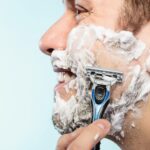Shaving can be a real challenge for people with acne or problem skin. Skin irritation, razor bumps and ingrown hairs are just some of the problems that can occur. However, there are ways to make shaving gentle on the skin and minimize the risk of inflammation.
Which shaving method is best for acne?
Electric shaver or wet shave?
The first question that many people with acne or problem skin ask themselves is: electric shaver or wet shave? Both methods have their advantages and disadvantages, especially for sensitive skin.
Wet shave: It is often considered to be more thorough. However, it does carry the risk of causing skin irritation or razor bumps. This happens in particular when blunt blades are used. A sharp razor and the right technique are essential to avoid cuts or inflammation.
Electric shaver: An electric shaver can be a gentler alternative to wet shaving. Many people with sensitive skin or acne prefer this method. Direct contact between the blade and the skin is reduced. The risk of injuring the skin is lower. This is particularly useful for acne. Open areas or pimples could become very irritated.
Advantages of an electric razor for acne
Electric shavers are often the gentler choice for people with acne. They avoid direct contact between the sharp blade and the skin, which reduces the risk of cuts and skin irritation. They also cause fewer razor bumps as they do not penetrate the skin as deeply as wet shaving. Skin problems can be further reduced by regularly cleaning the razor and using gentle, antibacterial skin care products.
How do I best prepare my skin for shaving?
Thorough preparation of the skin before shaving is the key to an irritation-free shave. This step can help prevent inflammation, especially if you have problem skin or acne.
Cleansing the skin before shaving
Before shaving, you should wash your face thoroughly with a gentle, skin-friendly cleanser. Make sure you choose products that do not contain harsh chemicals or fragrances, as these can further irritate the skin. A lukewarm facial cleanser opens the pores. This helps to prepare the skin for shaving. It also helps to prevent ingrown hairs.
Exfoliation to prevent ingrown hairs
A gentle exfoliation routine before shaving can help remove dead skin cells and reduce the risk of ingrown hairs. People with acne should avoid mechanical exfoliants. Instead, they should use chemical exfoliators, such as salicylic acid in low concentrations. These soothe inflammation and smooth the skin. They do not irritate the skin.
Which products are suitable for sensitive skin when shaving?
Choosing the right shaving products is particularly important to avoid skin irritation. People with sensitive skin or acne should opt for gentle products. These products should not contain alcohol. They should also not contain any fragrances.
Gentle shaving creams and gels
Shaving creams and gels that have been specially developed for sensitive skin often contain soothing ingredients such as aloe vera, camomile or oat extract. These ingredients help to soothe skin irritation and make shaving smoother. Avoid shaving products that contain perfume or harsh chemicals as they can dry out the skin and cause irritation.
Antibacterial shaving products for acne
Antibacterial shaving products can be useful for acne-prone skin. They prevent bacteria from penetrating open pimples or inflamed areas and thus worsening skin problems. However, make sure that these products are gentle. They should not have a high alcohol content. Alcohol can dry out the skin and cause irritation.
Which technique is recommended for acne or problem skin?
In addition to the right products, shaving technique is also crucial. The wrong technique can increase the risk of skin irritation and ingrown hairs.
Shave with or against the direction of hair growth?
It is generally recommended to always shave in the direction of hair growth if you have sensitive skin or acne. This reduces the risk of ingrown hairs and skin irritation. Shaving against the direction of hair growth can lead to a smoother result. However, it puts more strain on the skin. It can also lead to razor bumps.
Light pressure and gentle movements
Only apply light pressure when shaving and avoid shaving over the same area several times. This could irritate the skin unnecessarily and increase the risk of inflammation. A clean and sharp blade ensures that shaving is efficient even without strong pressure.
The right care after shaving
After shaving, it is particularly important to care for the skin properly to prevent inflammation and skin irritation.
Moisturizing care
People with acne or sensitive skin should use a light, non-comedogenic moisturizer. This cream soothes the skin and provides it with moisture. It does not clog the pores. Products with aloe vera, hyaluronic acid or ceramides are particularly suitable as they moisturize and strengthen the skin barrier.
Aftershave without alcohol
Use an alcohol-free aftershave to soothe and disinfect the skin after shaving without drying it out. Products with anti-inflammatory ingredients such as tea tree oil or chamomile can help prevent skin irritation and soothe inflammation.
Conclusion: How to avoid skin problems when shaving
The best shaving method for acne or problem skin depends on various factors. These include the choice of shaving method, the right shaving products and a gentle shaving technique. Electric razors are often the gentler option. They have less direct skin contact and minimize the risk of cuts and razor bumps. Good skin preparation, gentle care products and the right aftercare can help prevent skin problems after shaving.

